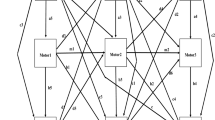Abstract
The skills and social impairments of a total population of children with severe intellectual disabilities and/or autism from Camberwell, South London (Wing and Gould, 1978 and 1979), were assessed using the Handicaps, Behaviours and Skills schedule, and they were reassessed when they were adolescents and young adults (Shah, 1986). Changes in social impairment over time are presented here. As Shah (1986) had found with a smaller sample, social impairment remained relatively stable over time: on a simple “socially impaired” versus “sociable” dichotomous grouping, 93% did not change social group. Within the socially impaired group, there was a significant increase in impairment over time (i.e., people who were passive at Time 1, were aloof at Time 2). Implications of these results and predictions for a further follow-up study are discussed.
Similar content being viewed by others
REFERENCES
Bayley, N. (1969). Bayley Scales of Infant Development. New York: Psychological Corporation.
Beadle-Brown, J., Murphy, H., Wing, L., Gould, J., Shah, A., & Holmes, N. (2000). Changes in skills for people with intellectual disabilities: A follow-up of the Camberwell Cohort. Journal of Intellectual Disabilities Research, 44, 12–24.
Gillberg, C., & Steffenburg, S. (1987). Outcome and prognostic factors in infantile autism and similar conditions: A population based study of 46 cases followed through puberty. Journal of Autism and Developmental Disorders, 17, 273–287.
Gould, J. (1976). Language development and non-verbal skills in severely mental retarded children: An epidemiological study. Journal of Mental Deficiency Resources, 2, 129–146.
Graham, D., & Rutter, M. (1968). The reliability and validity of the psychiatric assessment of the child: II. Interview with the parents. British Journal of Psychiatry, 114, 581–592.
Howlin, P., & Rutter, M. (1987). The treatment of autistic children, Chichester: John Wiley.
Jacobsen, J. W., & Ackerman, L. J. (1990). Differences in adaptive functioning among people with autism or mental retardation. Journal of Autism and Developmental Disorders, 20, 205–219.
Kanner, L. (1943). Autistic disturbances of affective contact. Nervous Child, 2, 217–250.
Leiter, R. G. (1980). Leiter International Performance Scale: Instruction annual. Woodale, IL: Stoelting Co.
Lotter, V. (1978). Follow-up studies. In M. Rutter & E. Schopler (Eds.). Autism, A reappraisal of concepts and treatments. New York: Plenum Press.
Lovaas, O. I. (1987). Behavioural treatment and normal ducational and intellectual functioning in young autistic children. Journal of Consulting and Clinical Psychology, 55, 3–9.
Loveland, K. A., & Kelly, M. L. (1988). Development of adaptive behaviour in adolescents and young adults with Autism and Down syndrome. American Journal on Mental Retardation, 93, 84–92.
McCarthy, J., & Kirk, S. A. (1961). The Illinois Test of Psycholinguistic Abilities: Experimental edition. Urbana, IL: University of Illinois Press.
McEachin, J. J., Smith, T., & Lovaas, O. I. (1993). Long-term outcome for children with autism who receive early intensive behavioural treatment. American Journal on Mental Retardation, 97, 359–372.
Reynell, J. K. (1977). Reynell Language Development Scales (manual revised version, 1987). England: Nfer-Nelson.
Rogers, S. (1996). Brief report: Early intervention in autism. Journal of Autism and Developmental Disorders, 26, 243–246.
Rutter, M. (1970). Autistic children: Infancy to adulthood. Seminars in Psychiatry, 2, 435–450.
Rutter, M., Greenfeld, D., & Lockyer, L. (1967). A five to fifteen year follow-up study of infantile psychosis: 2. Social and behavioural outcome. British Journal of Psychiatry, 113, 1183–1199.
Rutter, M., & Lockyer, L. (1967). A five to fifteen year follow-up study of infantile psychosis: 1. Description of sample. British Journal of Psychiatry, 113, 1169–1182.
Rutter, M., & Lord, C. (1994). Autism and pervasive developmental disorders. In M. Rutter, E. Taylor, & L. Hersov. Child and adolescent psychiatry: Modern approaches (third edition), (pp. 569–593). Oxford: Blackwell Scientific Publication.
Schatz, J., & Hamden-Allen, G. (1995). Effects of age and IQ on adaptive behaviour domains for children with autism. Journal of Autism and Developmental Disorders, 25, 51–60.
Schopler, E., Short, A., & Mesibov, G. (1989). Relation of behavioural treatment to “normal functioning”: Comment on Lovaas. Journal of Consulting and Clinical Psychology, 57, 162–164.
Shah, A. (1986). Impairment of social interaction in autism and mental retardation: A 12 year follow-up study. In J. M. Berg (Ed.). Science and service in mental retardation (pp. 132–141). London: Methuen.
Stutsman, R. (1931). Merrill-Palmer Scale of Mental Tests, New York: Harcourt, Brace & World.
Wechsler, D. (1949). Wechsler Intelligence Scale for Children, New York: Psychological Corporation.
Wing, L. (1971). Severely retarded children in a London area: Prevalence and provision of services. Psychological Medicine, 1, 405–415.
Wing, L. (1988). The continuum of autistic characteristics. In E. Schopler & G. B. Mesibov (Eds.) Diagnosis and assessment in autism (pp. 91–110). New York: Plenum Press.
Wing, L., Bramley, C., Hailey, A., & Wing, J. K. (1968). Camberwell Cumulative Psychiatric Case Register Part 1: Aims and methods. Social Psychiatry, 3, 116–123.
Wing, L., & Gould, J. (1978). Systematic recording of behaviours and skills of retarded and psychotic children. Journal of Autism and Childhood Schizophrenia, 8, 79–97.
Wing, L., & Gould, J. (1979). Severe impairments of social interaction and associated abnormalities in children: Epidemiology and classification. Journal of Autism and Childhood Schizophrenia, 9, 11–29.
Wing, L., Gould, J., Yeates, S. R., & Brierley, L. M. (1977). Symbolic play in severely mentally retarded and autistic children. Journal of Clinical Psychology and Psychiatry, 18, 167–178.
Wing. J. K., & Hailey, A. M. (Eds.) (1972). Evaluating a community psychiatric service. London: Oxford University Press.
Author information
Authors and Affiliations
Rights and permissions
About this article
Cite this article
Beadle-Brown, J., Murphy, G., Wing, L. et al. Changes in Social Impairment for People with Intellectual Disabilities: A Follow-up of the Camberwell Cohort. J Autism Dev Disord 32, 195–206 (2002). https://doi.org/10.1023/A:1015401814041
Issue Date:
DOI: https://doi.org/10.1023/A:1015401814041




